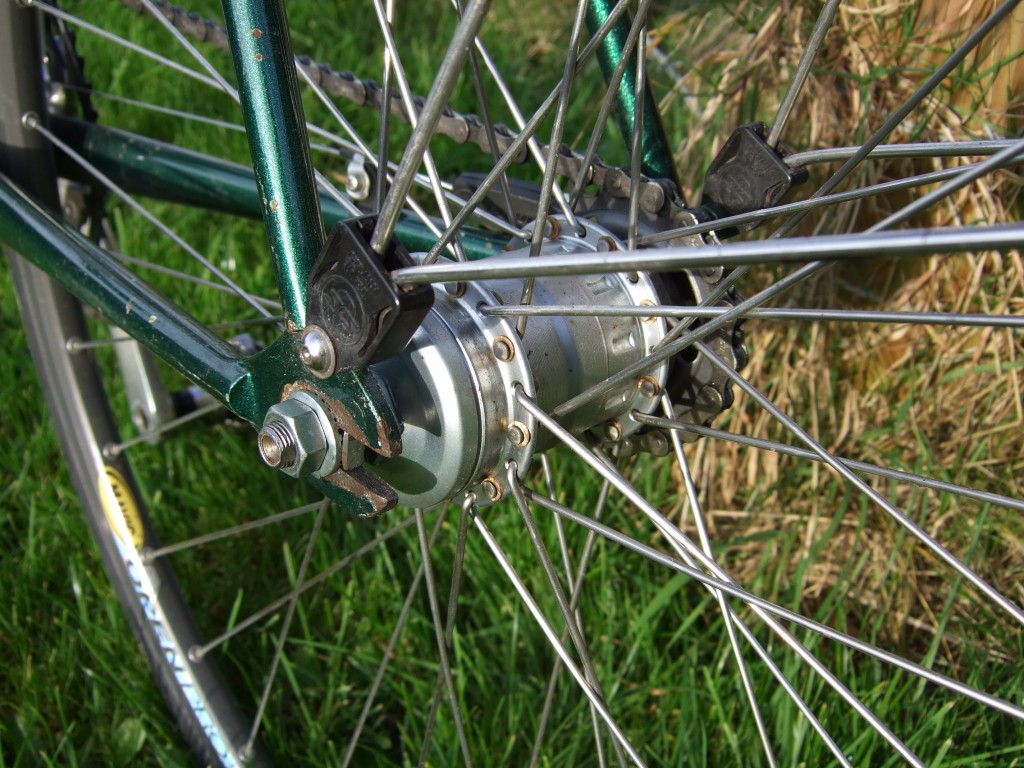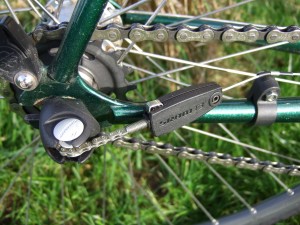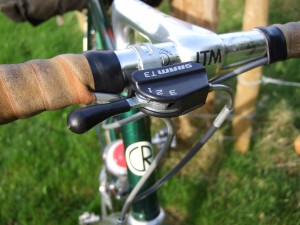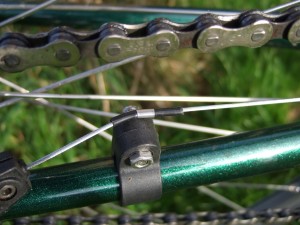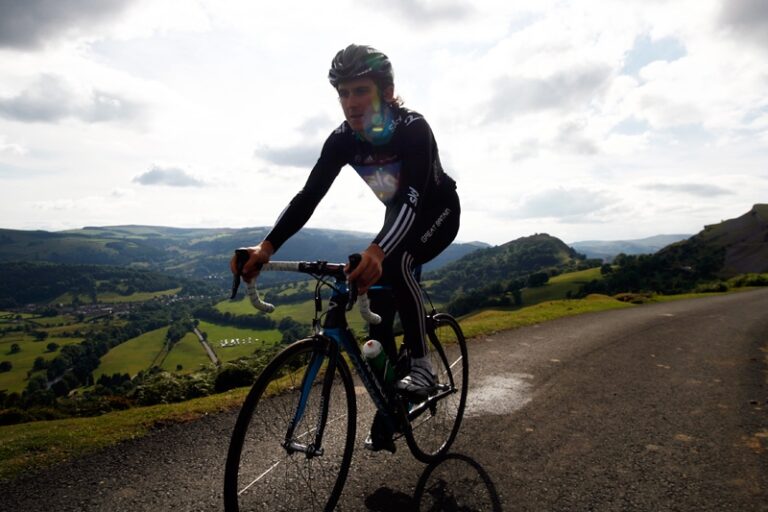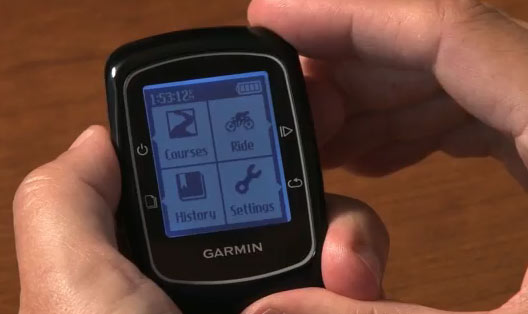
- Fixed wheel to three-speed
SRAM T3 three-speed hub £89.99
It won’t have escaped the notice of the average cycle commuter that
fixed wheel or fixed gear machines – often erroneously labelled ‘single-speed’ – are a popular choice for the task, especially in London.
There are, for sure, sound reasons for choosing a single sprocket, whether equipped with a freewheel or attached rigidly to the hub. The most obvious and compelling is simplicity; with only one sprocket, a straight chain line and no complex, vulnerable and – let’s be frank here – ungainly derailleur mech to worry about, a ‘fixed’ bike has few parts to wear out and needs minimal maintenance. Against this must be put the fundamental disadvantage over a geared machine; one gear ratio has to serve in all riding conditions.

- Familiar three-speed toggle chain
Naturally enough, the fixed wheel advocate tries to turn this into a plus point. The fixed rider has to develop a fast, supple pedalling technique to allow him or her to go quickly in favourable conditions, while the inevitably highish single ratio makes climbing the most paltry of hills a training session in itself. Never mind that there is a practical upper limit to an efficient pedalling cadence, that excessive mileage on fixed can damage knees and that a high single gear can be dishearteningly arduous work into the wind at the end of a long week – although that’s what a flip-flop hub’s for…
Luckily, a solution to this nonsense has been around for over a century in the shape of the hub gear. Originally developed and popularised by the legendary firm of Sturmey Archer, the hub gear offers the same benefits of easy maintenance, longevity and weather-proofing as the single speed transmission with none of the drawbacks. There are, today, many hub gears on the market with more than the traditional three speeds, but for many aficionados three is easily enough. Think about it: there’s one for regular conditions, one for climbing and one for when the going is particularly favourable.
One of the longest-lived and most respected hub gear manufacturers was the German firm of Sachs, which was bought a few years ago by SRAM. As a result, the excellent Sachs T3 three-speed, in manufacture for a century and often confused with the same firm’s Torpedo coaster-brake hub, is now known as the SRAM T3. Widely considered superior to the equivalent Sturmey Archer AW hub thanks to its immaculate machining and simpler internals, the T3 is available with a drum brake if required or as the plain hub shown here. SRAM used to list coaster and i-Brake versions, which may still be available. The company seems to have dropped the classic trigger shifter shown, but not only is this component – vital for use with dropped bars – still offered by SRAM distributor Fisher Outdoor Leisure, the T3 will happily work with a Sturmey trigger shift.

- Classic trigger shift is indexed
Luckily, it is an easy matter to fit one of these attractive hubs, which are a popular fitment on Brompton folding cycles, to most fixed wheel or geared machines as we have done here. The main requirement is a rear end Over Locknut Dimension of the track and fixed standard 120mm; although the wheel spindle is fairly long, it may not allow fitment to a 130mm rear end. The T3’s OLD is, in fact, 117mm, but it is easy enough to add a thin washer each side to get the exact width. The spindle is machined with opposing flat surfaces that match the hole in the serrated washers on each end. These, which sit outside the dropouts, have a tab that engages with the slot of the dropout or track end to prevent the spindle turning, which it will otherwise do as pedal torque is applied.
Unlike a fixed wheel transmission, the freewheeling hub can be used with a chain tensioner in a frame with vertical dropouts. In any case, chain tension is not critical and a degree of slack makes no difference to its running. It has a steel barrel and is only available with 36 spoke holes. Weight is just under a kilo. In time-honoured style, the shift mechanism is actuated by a toggle chain with threaded pin that is inserted through the hollow spindle. To ease the chain path, the SRAM design employs a plastic ‘deflection pulley’ wheel that clips over the right-hand wheel nut once it is tightened in place.
An effective quick-release system is employed for the control cable; the outer end of the chain joins a threaded pin that enters a large plastic locating sleeve. This is armed with a spring-loaded jaw that automatically engages with the thread as it is pushed into place. Adjustment is simple; with the trigger lever in top gear position, the toggle pin is pushed into the locating sleeve until there is no slack in the control inner wire. If there is any difficulty in selecting low gear, the cable is too tight and needs a hint of slack. That’s it; unlike the Sturmey hub, there are no free-spinning neutral positions that might catch out the unwary.

- Chainstay cable guide
The final consideration for anyone thinking of equipping their fixed bike with this hub is control cable routing. The writer rooted around in his box of things that clamp around tubes and came up with a Deda Dog Fang, a Travel Agent, a cyclo-cross front mech cable pull-reversing pulley thingy and one of those small diameter round plastic clamps you get with rear lights and played around with them to achieve the result shown. The pulley wheel is perhaps the hardest part to get right; a Sturmey wheel with tube clip will do the job nicely.
Riding is, of course, the proof of this pudding and the good news is that it is perfectly cooked all the way through. So it should be after 100 years in production. In fact, there are a few irritations to ignore: the gear ratios are necessarily weirdly spaced, middle gear has about 30degrees of slack before it engages and there’s that constant ticking in top and middle gears. Mind you, the ticking seems to annoy riding companions more…
The nature of the epicyclic mechanism means that each up shift makes the same percentage gear change; from low to middle is, in this case, a jump of 36%, as is the jump from middle to top. This, of course, means that the drop from middle to bottom is 26% of middle… Unfortunately, it is usually thought better to have smaller jumps as the gears get bigger.
Shifting is immediate and can be done while stationary. Middle or normal gear gives direct drive, locking the mechanism so the wheel and sprocket turn together. The hub is shielded, not sealed, so there is no friction from this source. Add to this the large diameter of the hub bearings and balls and you have an exceptionally free-running device, although one you do not want to submerge… For sure, the hub is more than able to keep out wet weather.
With a 19t sprocket and 48t ring, normal gear is 67”. This gives a low gear of 51” and high of 94”; it doesn’t take too much imagination to see what happens when you engage top gear. You’d better have a chuff wind or be able to half-wheel Fabian Cancellara to choose it on the flat… Going downhill or with that wind, however, it is awesome, with a really solid feel thanks to the direct chainline and large rear sprocket. Low is low enough for almost anything and much better than having to heave a high fixed gear over.
To date, the Roberts Three Speed has been used for commuting when it rains and has completed a three-day tour with luggage (in a saddlebag, of course) with derailleur-equipped companions, all of whom complained that the gears were not quite compatible with theirs… See you on 72” any day.

